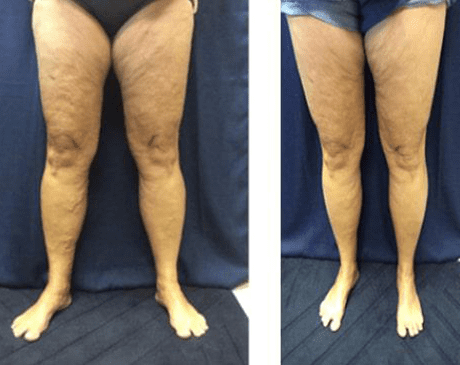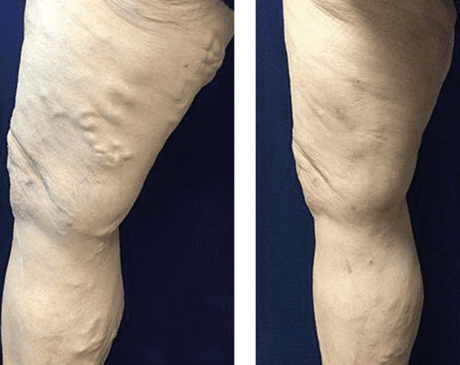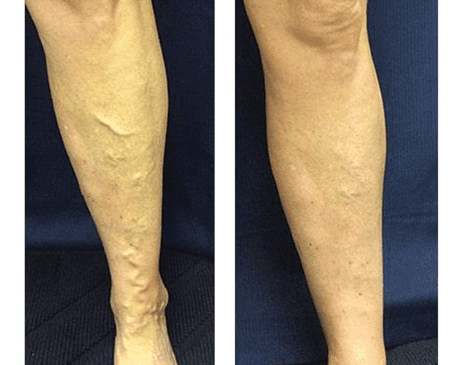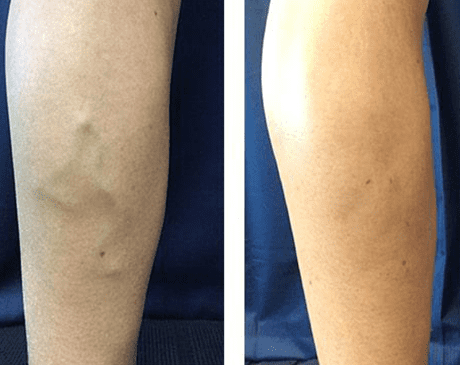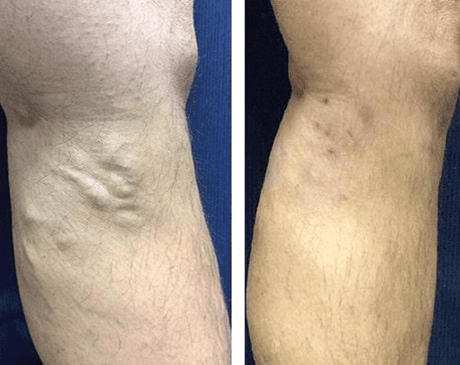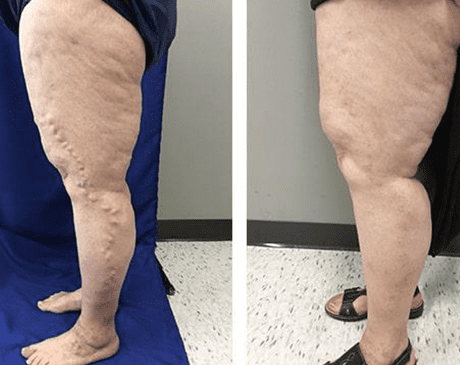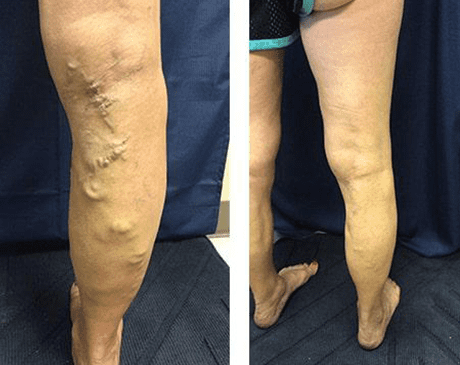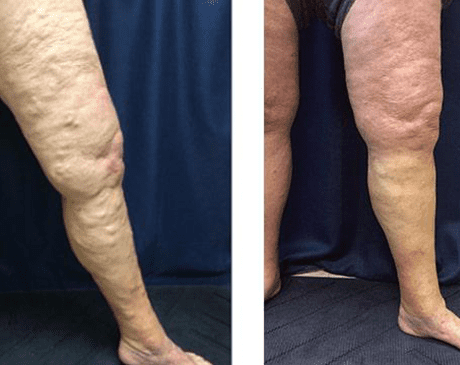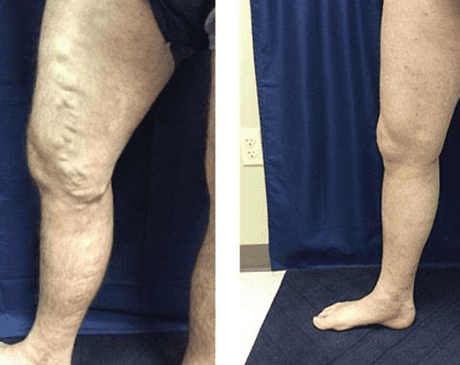Varicose Veins
Varicose Veins
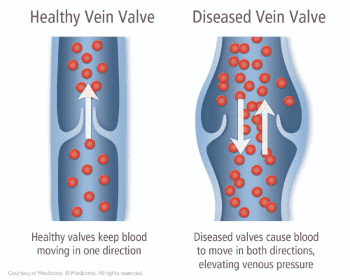 Healthy veins have one-way valves to ensure blood flows in one direction, towards the heart. When valves fail or leak, the blood flows backwards causing it to pool in the veins. The increased pressure from the pooling stretches the vein, causing enlarged, twisted blood vessels. The resulting lumpy, rope-like veins are varicose veins.
Healthy veins have one-way valves to ensure blood flows in one direction, towards the heart. When valves fail or leak, the blood flows backwards causing it to pool in the veins. The increased pressure from the pooling stretches the vein, causing enlarged, twisted blood vessels. The resulting lumpy, rope-like veins are varicose veins.
While some varicose veins only pose a cosmetic problem, some cases may cause substantial discomfort and health complications. Left untreated, varicose veins can lead to swelling, increased pain, skin discoloration and ulcerations of the lower legs. These ulcerations are difficult to treat and can become easily infected and painful. Many of these symptoms and complications can be prevented by early treatment of varicose veins.
Treatment Options
Trivex
Micro-Phlebectomy
Venous Stent
EVLA
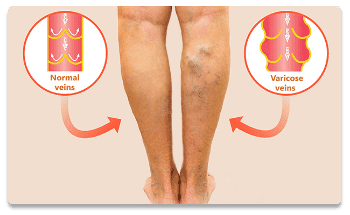 Similar to ClosureFast radiofrequency ablation, Endovenous Laser Ablation is an in office minimally invasive procedure performed under local anesthesia to close malfunctioning veins from the circulation. A small needle is used to access the targeted vein, and ultimately a sheath is placed to deliver the laser fiber. Once the fiber is in place, energy in the form of heat is used to damage the collagen of the vein causing the vein to collapse and seal. The blood that was previously flowing through this poorly functioning vein is now rerouted into healthy veins that will return the blood more efficiently. A Bandaid is placed over the access site. The procedure usually lasts ~ 30 minutes and the patient can return to work the next day if needed.
Similar to ClosureFast radiofrequency ablation, Endovenous Laser Ablation is an in office minimally invasive procedure performed under local anesthesia to close malfunctioning veins from the circulation. A small needle is used to access the targeted vein, and ultimately a sheath is placed to deliver the laser fiber. Once the fiber is in place, energy in the form of heat is used to damage the collagen of the vein causing the vein to collapse and seal. The blood that was previously flowing through this poorly functioning vein is now rerouted into healthy veins that will return the blood more efficiently. A Bandaid is placed over the access site. The procedure usually lasts ~ 30 minutes and the patient can return to work the next day if needed.Varithena
Highlights of Procedures:
- Relief of symptoms
- Resume normal activity within a day
- Outpatient procedure
- Local anesthesia
- Good cosmetic outcome with minimal to no scarring, bruising or swelling
What is venous insufficiency?
Venous insufficiency is a condition that occurs when the valves of the veins in the legs do not close properly. The veins in your leg bring blood back to the heart in a one-way direction, the valve would open to allow blood through and close to prevent blood from flow backward. When the valves don’t close properly, blood can flow back to your foot which can lead to swelling and ulcer.
What are varicose veins?
Varicose veins are enlarged veins mostly occur in your legs due to weakened or damage to the valves. Varicose veins usually are very visible under the skin and get larger when standing for a long time. Varicose veins can cause pain and swelling to the legs.
What are spider veins?
Spider veins are very small veins that appear on the legs, especially in the thigh and calf, that look like spider webs on the skin. Spider veins are usually do not cause any symptoms.
What are reticular veins?
Reticular veins are slightly larger veins than spider veins that occur usually on the thigh or calf. It can cause bleeding if cut or during shaving. It can also cause pain.
How do I prevent venous insufficiency?
Activities that can help with preventing venous insufficiency including moving around intermittently, no sitting or standing for prolonged period of times. Do not wear restricted clothing. Regular excise and heart healthy diet
What is an endovenous ablation?
Endovenous ablation is a procedure perform to close off disease veins in the leg without surgery. The procedure involves accessing the vein with a needle and catheter to introduce heat to the vein to close the vein.
How does the VenaSeal Closure work?
Venaseal Closure is procedure perform to close the disease vein in the leg. The procedure involves accessing the vein with a needle and introducing a catheter into the disease vein to administer a medical glue to close the vein.
What is sclerotherapy?
Sclerotherapy is a procedure in which a physician accesses a small vein in the leg to inject medication into the vein to close the vein.
How does compression therapy work?
Compression therapy work by provide compression to the calf or leg to improve the return of the blood to the heart. This especially helpful for patient with venous insufficiency in which the valves in the veins do not close all the way.
What is a stab phlebectomy?
Stab phlebectomy is a surgical procedure in which a physician made a small incision on the leg to remove the disease veins in the leg.
What is the down time following vein procedure?
Patients take the day of the procedure to rest and do normal light activities and can resume normal activities the next day.
What is May-Thurner Syndrome and how is it treated?
May-Thurner Syndrome is the compression of the vein in the pelvic from the crossing artery. Usually happen to the left lower extremity. Usually May-Thurner Syndrome causes swelling to leg to the narrowing of the vein or clotting of the veins.
Treatment of May Thurner usually required removal of clots in the vein if clot develop and ballooning of the narrowing of the vein and possible stenting of the vein.
What is Nutcracker Syndrome and how is it treated?
Nutcracker Syndrome is a compression of the left renal (kidney vein) between the aorta (larger artery in the abdomen) and superior mesenteric artery (artery of the bowel). Compression of the left renal vein can use flank pain on the left side and blood in the urine.
Treatment of Nutcracker Syndrome start with a venogram to confirm the diagnosis of Nutcracker syndrome. The gold standard treatment is surgery to move the vein to relieve the compression.

